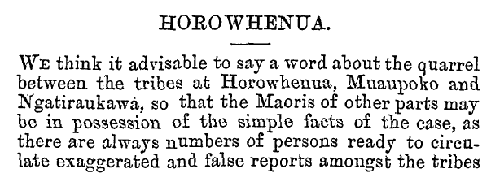
The arrival of other tribes in the Wellington region from 1822 onwards led to a number of conflicts over land ownership. Shown above are the opening lines of an article that was published in the Māori newspaper Te Waka Maori o Niu Tirani in December 1873. The article, printed in Māori and English, outlines a dispute over land at Horowhenua between the Muaūpoko and Ngāti Raukawa tribes. The full text can be read below:
HOROWHENUA.
E mea ana matou he mea tika kia whakaputaina e matou tetahi kupu mo te ngangare o nga iwi ki Horowhenua, ara a Muaupoko raua ko Ngatiraukawa, kia ata rongo ai nga Maori o etahi wahi ki te tikanga o taua mea; no te mea he nui nga tangata e noho nei hei whakanui noa i taua korero ka tuku ai ki nga iwi haere ai te korero parau. Kua mohio katoa koutou ki tera kainga, ki Horowhenua, he kainga ia no Muaupoko anake i mua ai; a no te taenga mai o Ngatiraukawa me te Rauparaha ma, me ana iwi, ki tenei tai, ka noho a te Whatanui ki taua kainga, a ko ona uri e ki ana na ratou inaianei taua kainga (tetahi wahi). Na, no te whakawakanga i te Kooti Whenua Maori ki Pokitana, i Aperira i tenei tau, ka whakataua taua whenua ki a Muaupoko. No tenei marama, no Tihema, ka tahuna a Kawana Hunia etahi o nga whare o Ngatiraukawa i runga i taua whenua, ka hutihutia nga taewa e tupu ana i waenga. No reira te ngangare i ngangare ai. I korerotia mai ki te taone ki Poneke nei kua mate etahi tangata—rongo rawa atu he parau, kaore ano i pupuhi noa, engari e kakari a waha ana. Kei reira nga apiha o te Kawanatanga inaianei e korero ana; kaore pea he whawhai pu. E pai ana kia whakaotia paitia i runga i te korero pai. Kaore rawa he mea uaua e kore e oti i te ata korero marire. Ki te tangohia ko te pu hei whakaoti ka mate tahi akuanei, a katahi ano hoki ka kore rawa e tata ki te oti.
We think it advisable to say a word about the quarrel between the tribes at Horowhenua, Muaupoko and Ngatiraukawa, so that the Maoris of other parts may be in possession of the simple facts of the case, as there are always numbers of persons ready to circulate exaggerated and false reports amongst the tribes in such cases. You are all aware that Horowhenua at one time belonged to the Muaupokos alone; and that, when Ngatiraukawa and Rauparaha and their people migrated to this coast, the Whatanui took up his residence at that place, and that his descendants now claim the land there. At the sittings of the Native Lands Courts at Foxton, in April this year, the land in question was declared to be the property of Te Muaupokos. During this month December, Kawana Hunia set fire to some houses, belonging to Ngatiraukawa, on the said land, and pulled up their potatoes. This was the cause of the quarrel. It was reported in Wellington that some persons had been killed, but this was not the case, there had been no firing—merely a wordy war. Officers of the Government are upon the spot reasoning with the Natives, and it is not probable that firearms will be resorted to. It is to be hoped the affair will be settled by quiet discussion. There is no question, however difficult, which may not be settled by quiet deliberation. If it be attempted to settle the dispute by an appeal to arms, both sides will suffer, and a settlement will be farther off than ever.
Using this item
Te Ara - The Encyclopedia of New Zealand
Reference:
Te Waka Maori o Niu Tirani 9, no. 20 (24 December 1873): 188.
This item has been provided for private study purposes (such as school projects, family and local history research) and any published reproduction (print or electronic) may infringe copyright law. It is the responsibility of the user of any material to obtain clearance from the copyright holder.





Add new comment